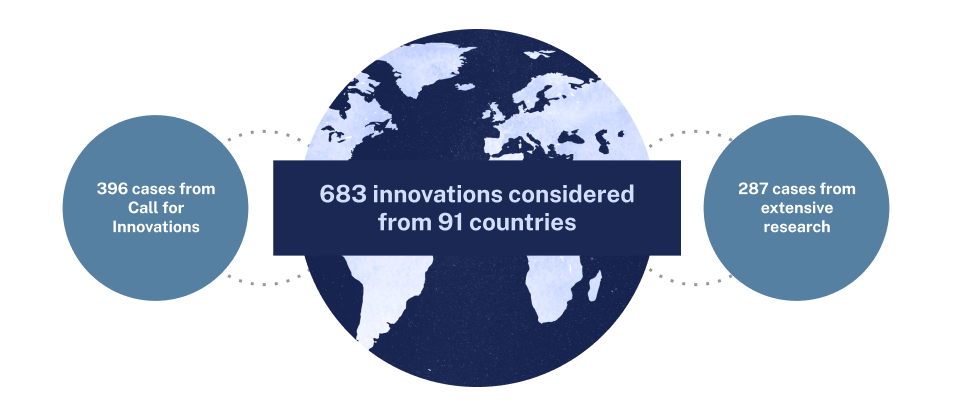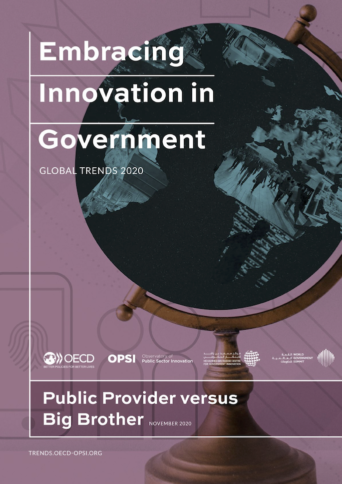Download the Report
Embracing Innovation in Government:
Global Trends 2020
OPSI and the MBRCGI have spent much of the last year working to understand how governments are innovating to cope with rapid change. We have conducted extensive research, held a global Call for Innovations crowdsourcing exercise, and met with innovative teams from around the world to surface key trends, examples and stories. Through this work, OPSI and the MBRCGI have found that governments are testing and implementing exciting and innovative new approaches, transforming the ways in which they operate and serve their people.

The fourth report in this series explores the powerful new technologies and opportunities that governments have at their disposal to let them better understand the needs of citizens. The research shows that governments must balance the tensions of using data harvesting and monitoring, and technologies that can identify individuals, to serve the public interest, with the inevitable concerns and legitimate fears about “big brother” and risks of infringing on freedoms and rights. Through the lens of navigating Public Provider versus Big Brother, innovation efforts fall into two key themes:
Theme 1: Data harvesting and monitoring
Governments have access to more detailed data than ever before, but such access involves risks and considerations which require serious reflection on the part of government.
Theme 2: Biometric technologies and facial recognition
A range of biometric tools offer opportunities to provide tailored services, as well as the unprecedented ability to identify and track individuals' behaviours and movements.

A digital world produces an incredible amount of data, which can provide governments with important insights into real-time events, trends and behaviours on the ground, especially in emergency situations. Analyzing this data can help governments quickly respond to current and potential issues with wide-ranging impact from preventing wildfire deaths to reducing homelessness. As governments gain access to richer data and better tools of analysis they can better understand problems and deliver services to their citizens.
Related to and often building upon data harvesting, advancements in technology are also providing governments with more powerful abilities to survey real-time events through monitoring . While monitoring can include surveillance and sometimes has a negative connotation, it is viewed as an important tool in bureaucratic administration and a growing trend among governments. A common manifestation of modern day monitoring and surveillance is the use of cameras, such as through closed-circuit television (CCTV). Governments are increasingly developing innovative monitoring approaches, such as through the use of drones and combining monitoring techniques with Artificial Intelligence (AI).
Data harvesting and monitoring are powerful approaches that can uncover significant information that might otherwise have been ignored, missed or dismissed. However, use of this power is not without legitimate privacy concerns, and some governments have pursued questionable practices in this area. Governments thus need to prioritise data governance and ethics so that citizens can have trust in their governments to use their data for public value.

Women and men move through cities differently, and government policymaking needs to take these differences into account when designing policies and services. Women also undertake more multi-stop trips to perform chores and also alter their behavior based on fears of victimisation and harassment.
In 2018, UNICEF researchers began working with the New York University (NYU) GovLab and other organisations to build a “data collaborative” to analyze gendered mobility data in Santiago, Chile based on mobile phone tracking. The results — based on a combination of this anonymized phone data with public demographic data — showed that mobility in this city was gendered, with women visiting fewer places than men and women more likely to return to the same preferred locations again.
Through understanding the lives of their citizens in greater detail, governments can start to make more targeted and bespoke policy interventions for particular demographics. While the efforts have only recently concluded, municipal and national government organisations have expressed interest in the findings.

Biometrics involves the use of automated tools to identify an individual through physical characteristics, such as fingerprints, iris scans or face recognition. Many people use biometrics multiple times a day, for example when unlocking an iPhone. Governments are increasingly leveraging biometric technologies to develop streamlined and tailored services for their citizens and residents.
However, governments must also grapple with the complex ethical and privacy issues that using such technology creates. Demand for more ethical practices has been increasing, reflecting a widespread interest in ensuring that data, including biometrics, are used in ways that respect the public interest and deliver trustworthy outcomes. As biometrics continue to grow — in everything from transportation to health care — governments and other organisations are designing frameworks and principles to prevent potential misuses or mitigate privacy risks.

As biometric identification technology proliferates, some governments are exploring how they can best use this technology to enhance the lives of their citizens.
In Singapore, ecosystems are being built around SingPass, an ID card that provides access to government services, including those related to taxes and welfare, as well as private sector services. Since 2017, Singapore has integrated this platform into a National Digital Identity (NDI) with the aim of creating digital identities for its citizens connected to these services. To address issues with this integration — primarily around security and authentication issues — Singapore is using facial recognition to streamline the authentication process.
While the program is optional for citizens, it has already proven successful when piloted at a number of government agencies. Facial verification has significantly reduced queueing times in where it has been implemented with user kiosks. The government has taken a number of steps to help ensure ethical use and application of the technology, with a specific focus on user consent.

Aid organisations from national agencies to international and non-governmental organisations (NGO) are increasingly using biometric data to help people in humanitarian crises. For example, facial recognition technology is used to help register beneficiaries with aid programmes. However, the use of biometrics also presents unique risks given the unique context of humanitarian crises. Beneficiaries of this technology are in a particularly vulnerable situation and may consequently compromise their rights in order to to obtain the assistance they need. Therefore, it is vitally important that biometric data are used in responsible and transparent ways and that the safety of vulnerable people is not compromised.
Accordingly, the International Committee of the Red Cross (ICRC) has developed its own policy to ensure the transparency of its actions and the safety of its beneficiaries. While not a government organisation, ICRC’s efforts can provide lessons to government and help to surface important thinking about how to approach biometrics.
New technologies allowing for the collection and application of new types of data and observations about people are proliferating, and governments around the world are exploring how they might engage with them. However, as with any emergent technologies, governments must experiment with possible approaches, and carefully examine and explore relevant considerations.
The use of data harvesting, monitoring, surveillance and biometrics for application such as facial recognition involve highly complex issues that need to balance multiple concerns and respect the core values and expectations of government. The following recommendations are offered as a guide for countries as they engage with these issues:
Additional details on these recommendations, as well as tools and resources for achieving them, are discussed in the full report.
Governments have increasing amounts of data about their citizens and the world at their fingertips, and have a responsibility to use these data and information actively to improve the lives of people, such as we have seen lately with governments using data to respond to the COVID-19 crisis. These methods are saving lives and are often widely accepted, highlighting a broad understanding that governments can indeed find a balance between using these new methods to improve the lives of their citizens while managing legitimate concerns around issues such as privacy and security.
These activities are just one aspect of an emerging trend where governments use data and information about their citizens to be collected on scales and speeds previously unseen. Real-time data collection can help inform emergency response services, and allow governments to make more informed policy decisions.
Questions, however, loom over the use of this sort of technology, in particular around privacy and security. What if this information was used in the wrong way, or by the wrong people? The public must understand how their data is being collected, stored and used. Accordingly, openness and transparency is incredibly important – governments must actively demonstrate that they are using these technologies in the interest of citizens, in order to generate and retain their trust. If the right governance and infrastructures exist around data security and commitments are made to be transparent and open about its use, then people are willing to accept different technologies in different situations.
Currently, these issues are arising and being addressed on a case-by-case basis. Too few countries or organisations have engaged in public debates about the use of these technologies in order to generate policy frameworks, which, if properly implemented, would constrain negative consequences, while enabling growth, through the added confidence and faith of people and businesses. If governments are going to get to grips with this technology – and they must, for the sake of their citizens – then it must necessarily be accompanied by the development of frameworks around the world governing its application.
